use code REFTOM to get access to free shipping
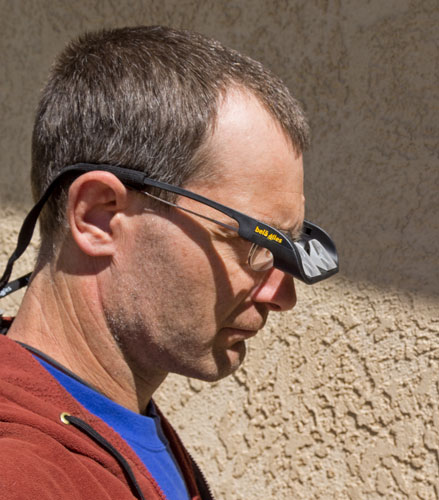
The purpose of this page is to try to explain all those arcane climbing terms I use in my trip reports. Hopefully I can get pictures to illustrate most of these terms too. It is a work in progress and probably won't ever be complete. Instead of putting things in alphabetical order I will try to group like terms together. Use [ctrl]-f (or whatever your browser equivalent is) to search for a term. If a particular term confuses you I can try to include it here and maybe even get a picture to illustrate it.
Free Climb Climbing without using the rope or equipment to rest or for upward progress. The gear is solely for safety in case of a fall and for descending. On a longer climb you can fasten in at the anchors between pitches and still consider it a free climb, although some would argue about this.
French Free Climbing where you pull on gear to help in the ascent - most often where you are climbing something long and the emphasis is more on doing it quickly than freeing every move. It can also let you free climb most of a climb that has a few moves that are beyond your abilities.
Aid Climbing climbing up where the gear is used to stay on the wall and to go up - often with webbing ladders (aiders) to stand in.
Aiders, Etriers a ladder usually constructed of webbing used to stand and go up an aid climb.
Sport climbing Sport climbing usually refers to climbing with bolts permanently placed in the rock for protection. The emphasis can be more on the difficulty of the climbing but not always.
Trad, Traditional climbing Trad climbing usually refers to climbing without bolts using removable protection placed by the leader.
Pitch A section of climb from one anchor to the next. Originally this was up to about 140 feet (so that climbers with a 150 foot rope could do it while tied in to both ends). As ropes have gotten thinner and longer some pitches have also gotten longer.
Single Pitch A climb that is only one pitch long - usually under 30 meters in length so that the climber can be lowered with one 60 meter rope. Some climbs now require a 70 or 80 M rope to be lowered and others are a full rope length.
Multi Pitch A climb that is more than a single pitch. This means the climbers have to stop somewhere part way up the climb to belay.
Linking Pitches If you do 2 or more pitches in one go then you are linking pitches. This can be done to save time, but sometimes the extra gear and rope drag makes it less efficient.
Simul-Climbing This is where both climbers are climbing at once. Nobody is belaying but they are still both tied to the rope and there should be some gear or other protection between them (one hopes for 2 or more protection points). A fall can be very bad, but hopefully not catastrophic. Often it makes sense for the stronger climber to follow because if the second climber falls both climbers are probably pulled off but if the leader falls the second climber gets pulled up, not down.
Free, Send, Clean, Redpoint, Get, etc. Climbers have many terms for successfully climbing something from the bottom to the top without falling or weighting the rope or gear. (if the rope is reasonably tight then weighting it might give you a rest or keep you from falling).
On-sight Climbing something the first time you try without previous knowledge or information.
Flash Climbing something the first time but with information such as watching someone else climb it or getting told the beta
Beta from Betamax tapes - the technique used to do a move or climb
Beta spew, Beta Spray, spray someone telling you the moves on a climb - often as you climb it. e.g. "I am going to try to flash this climb, can you spray me down"
spray Spray can also mean bragging about something you did - usually used in a pejorative sense. "I couldn't stand all those guys spraying about their trip to Hueco so I left"
Redpoint Climbing something from the bottom to the top on lead without a fall or weighting the gear. It implies that you have tried more than once.
Pinkpoint no longer really used - a redpoint where the quickdraws or gear was already placed. With steeper and steeper routes people tend to leave the draws in place due to the extra effort involved with cleaning. Plus some places have fixed or perma-draws that are there permanently. It can also refer to a traditional lead where the gear is already in place.
Punk-point The equivalent of a redpoint but on a toprope
Belay Glasses or goggles Glasses with mirrors or prisms to allow the belayer to observe the climber without bending their neck - thus avoiding cricking their neck and getting belayer's neck.
 |
|---|
Rappel, Rap, Abseil To descend by sliding down the rope, usually using some sort of device to provide increased friction. Not to be confused with repel. If you double the rope over or use 2 ropes then you can pull them down after you get down yourself (leaving whatever they were passed through or around at the top of the rappel). Abseil is the British term.
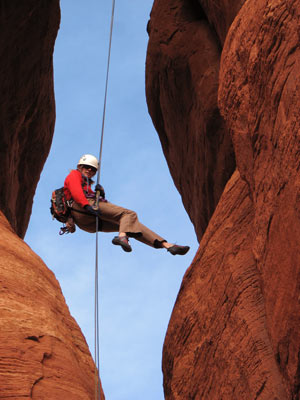 |
|---|
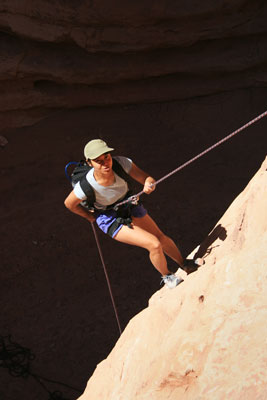 |
|---|
Carabiner, 'biner, krab, karabiner A metal oval with a snap gate that can be opened to connect or disconnect it. Not to be confused with a beaner. A locking biner has a way to keep the gate from opening by accident. They come in various shapes such as oval, pear, d, and modified d. They also have solid, wire, or bent gates and the gates can be made more secure with a pin and notch or a keyhole shape.
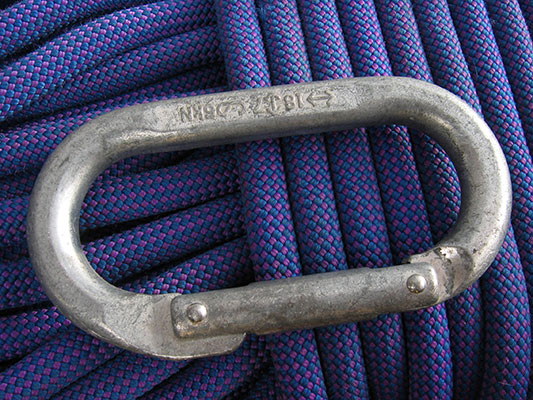 |
|---|
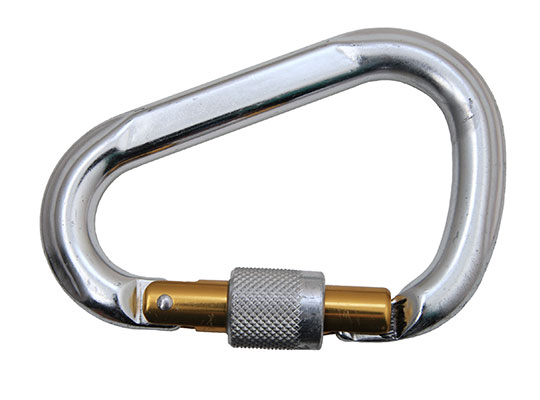 |
|---|
HMS Carabiner This is a carabiner with a wide enough opening to allow the use of a Munter Hitch for belaying or rappeling - HMS is an abbreviation of Halbmastwurfsicherung - German for using a Munter Hitch or something like that. (My sister says�"Halbmastwurfsicherung" would literally mean "half-mast throwing safety device," if that makes any sense. �Or instead of "safety device" the word "Sicherung" can also mean "security" or "safeness.")
Quickdraw, Draw, Dog-bone This can refer to the short webbing sling used to fasten 2 carabiners together or to the 2 draws and the sling combination. Usually made of nylon or other material (Dyneema, Spectra, etc. - stronger but less stretchy). For sport climbing the rope end of the quickdraw often has a bent-gate carabiner or wire-gate carabiner for easier rope clipping.
Sling A nylon or other webbing loop used for fastening stuff - usually gear or a tree and the rope or climber. Usually longer than a quickdraw. A single sling often is about 2 feet long so that it fits over the shoulder (a shoulder sling) and a double sling is twice that length. They can be tied from a length of webbing or sewn. A sewn sling is stronger but you can't untie it to thread it through something.
Cordelette A length of thinner cord 20' to 30' long tied into a loop. It is usually 5.5 to 8mm thick and used to fasten anchor points together to make a more secure anchor.
Prusik A friction knot that can be used to fasten a thin cord onto a thicker rope that can be slid and pulled tight. This can be used to climb up or down a hanging rope by alternating sticking and sliding 2 prusik knots. It is slow but works. The process of climbing on a rope with these knots is known as prusiking. Prusiking is also a more generic term for climbing up a rope with any of a variety of friction knots. Also prusik can refer to the loop of cord used for the knot. It is named after it's alleged inventer the Austrian mountaineer Dr. Karl Prusik.
Klemheist, Autoblock, Bachmann knots These are all other friction knots that are similar to the Prusik knot with various advantages and disadvantages. They can also be used for backup when rappeling.
Ascender, Jumar, Jugs, tibloc These are mechanical devices that slide on the rope one direction and grab when slid the other way. They are easier to use to ascend a rope than knots like the prusik, but some have teeth that can damage a rope in some situations. They also cost more and are heavier. They can be easier to use and also may work in conditions where the knots may fail such as icy ropes. These can also be used for the act of climbing up a rope - "After he got up the aid pitch I jugged my way up to the anchor".
ATC, Belay Device, tube belay, tuber ATC = Air Traffic Controller = Black Diamond's tube belay device. Used to control the speed the rope feeds to catch a falling climber or lower them or to rappel.
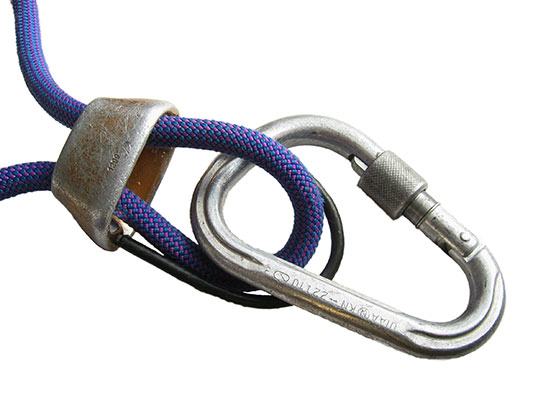 |
|---|
Gri-gri An autolocking belay device made by Petzl. It is heavy and a bit fiddly to pay out rope sometimes but also is supposed to lock on its own in the case of a fall. It is very nice for belaying a climber who is falling and hanging a lot. It can also be used as the lower rope attachment point when ascending a rope or to rappel a single rope strand.
Protection, Pro Safety gear that connects to the cliff. This can be bolts, pitons, nuts, cams, or slung trees, threads, or rock horns. It is connected to the rope with a carabiner.
Toproping, toprope, TR Climbing where the rope runs from the climber up to an anchor at the top of the climb and then back down to the belayer. The rope is always above the climber so that a fall should be only the length of rope stretch and any slack in the system.
Lead Climbing, leading Climbing from the bottom taking the rope with you and running it through gear attached to protection along the way. A fall means that you fall down to your last piece of protection plus that distance again and then farther due to rope stretch and slack in the system. Hopefully you have a belayer at the other end of the rope.
Crack Climbing Climbing up rock with a crack in it where you use the crack for holds to get up, and often for protection too. I have outlined the sizes below from smallest to largest.
Tips Crack A tips crack is too narrow to get any of your fingers in past a knuckle. These are generally pretty hard.
Finger lock Finger locks are a jam for thin cracks where you stick your fingers into the crack and twist or bend them to get them to stick. They can be quite secure but your feet are usually quite poor.
Thumb Stack A jam for a crack that is too fat for your fingers but too tight for hand jams (off fingers). To thumb stack you stick your thumb in with the last joint across the crack and slide one or more finger next to it to get it to stick.
Ring Locks Another technique between fingers and hands is the ring lock where you stick 2 fingers in next to each other in the crack and then your thumb in and bring them together like a ring to get it to expand and stick.
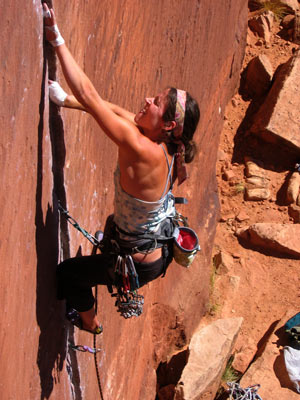 |
|---|
Hand Crack, Hand Jam A crack that you can get a hand jam in - from tight hands where you can't quite get the entire hand in to perfect hands - they fit in barely - to wide or cupped hands where you have to flex your fingers to make it stick. The hand is expanded by bringing the thumb towards the little finger side of the hand to get it to stick. It can also be rotated.
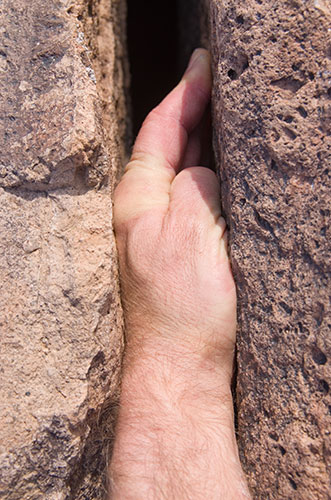 |
|---|
Fist Crack A crack too wide for a hand jam that you can get a fist jam - stick your hand in palm up or down and form a fist to make it stick. It can be solid but only covers a small size range.
Circle of Power A technique with a series of fist jams. The arms form a circle with the palms facing the body and the knuckles facing each other. You alternate with the hands together and apart to move up the crack.
Elbow Jam Depending on the size of your fist and your arms this is usually somewhere around fist size - you stick your arm in and then bend the elbow to expand it and stick. It can be quite solid but hard to move out of. I use it to rest and to place gear.
Offwidth - This is a crack that is too wide to fist jam but too small to squeeze into. This is a difficult size to climb often requiring a lot of grunting and effort for only a little upward progress. Also the gear to protect it tends to be expensive, heavy, and somewhat fiddly. It is sometimes abbreviated as OW.
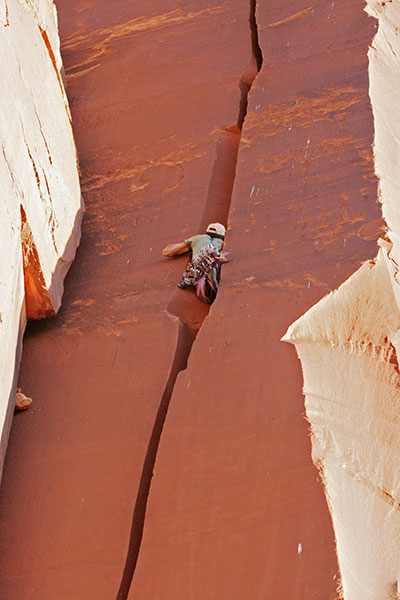 |
|---|
Hand Stack The first of the offwidth techniques is the hand stack where you put in both hands and jam them against each other. If you cross your wrists and put the back of the hands together that is known as the "butterfly".
Hand - Fist stack A wider OW technique employing one hand jam and one fist jam. I find this works best for me crossing my wrists and having both thumbs up.
Knee Jam Where you stick your knee into the crack and bend it to lock it in place. It can be secure but a little scary that it won't come back out.
Fist Stack An even wider OW technique where you stack both of your fists across the crack in fist jams.
Gay Hand Alf's OW technique where you bend your hand at the wrist and extend the fingers across the crack.
Arm Bar Where you stick your arm into the crack and try to bend it. It sort of sticks and is sort of tiring.
Chicken Wing Bend your arm completely at the elbow and stick that into the crack and push your hand against one side and either the back of your arm or your shoulder against the other. It can be secure but hard to move.
Foot Stack Where your feet are pressed against each other and against the sides of the crack.
Heel-toe Where the foot spans across the crack with the heel on one side and the toe on the other. You can also do a foot stack with one foot 90 degrees from the other in the heel-toe position against the other foot instead of the crack.
Squeeze Chimney For a squeeze chimney it is possible to get the body entirely into the crack, but it is tight. Sometimes so tight that you can only move when you breathe out and you can't turn your head. Falling is usually unlikely but it is hard to move upwards and protection is sparse. Also you have to watch out so that nothing gets stuck - like a helmet, chalkbag, gear, backpack, etc.
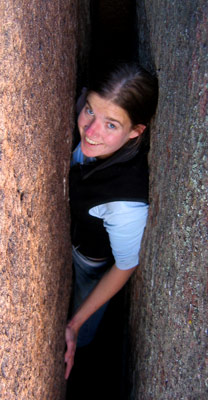 |
|---|
Chimney A chimney is a crack that you can fit into and span across in some way (back on one side and feet or knees on the other to, stemming, spread eagled, all the way to hands on one side and feet on the other). If there are holds it is pretty easy, if it is smooth it can be sketchy. Some sizes are much easier than others too. Also protection can be sparse.
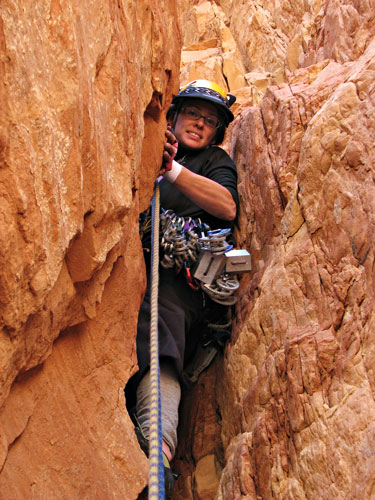 |
|---|
Bombay Chimney A bombay chimney is a chimney that is open on the bottom so that if you fall you drop right out of the bottom. Often they are not that hard but they are exciting.
Goby, gobies, rock rash Crack climbing can often damage the back of your hands (or other parts of your skin if you are climbing wide cracks). These can be refered to as gobies, rock rash, or other colorful terms.
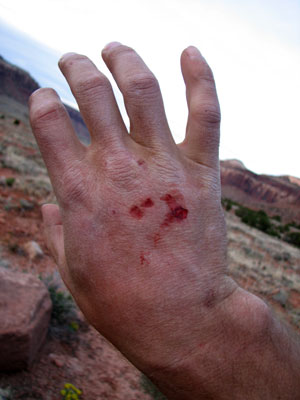 |
|---|
Crack Gear The size of a crack can also be described by the gear needed to protect the crack. (Ok, the crack doesn't need protection, the climber does, but that is how you would describe it - protecting the crack or the climb). These range from tiny rp nuts to big-bros. In the US they usually use Black Diamond Camalots to describe the sizes. For example hand cracks range from #1 (red) (tight hands for me) Through #2(gold) (pretty good hands for me) to #3 (blue)(fat hands to fist).
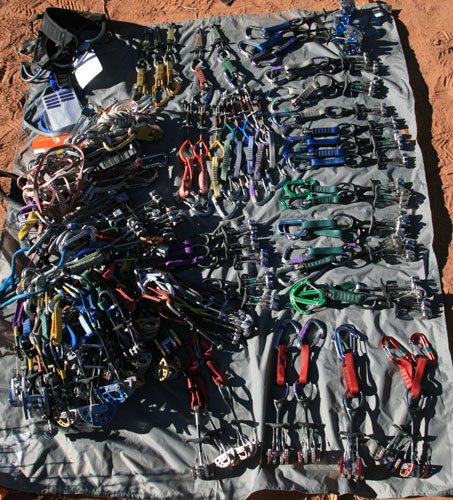 |
|---|
Rack A collection of climbing gear. This can refer to all of your gear together or the specific collection you are taking up a climb - sometimes on a shoulder sling, other times fastened to your harness. Getting ready for a lead can be refered as "racking up". For sport climbing it can also refer to the quick draws.
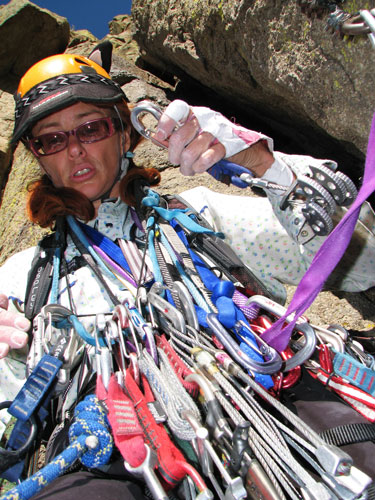 |
|---|
Booty Gear Climbing gear that you find or retrieve from climbs - often people are unable to get gear out of cracks or they have to leave gear behind for some reason and if you are lucky or persistent or have sneaky tricks you can get it out. There is something immensely satisfying about bootying gear beyond the value of the gear.
Cam A Cam is a device with spiral shaped cams that are held against the crack sides with springs. A pull on the cam pushes the cams against the walls locking it in place. Pulling a trigger retracts the cams for placement and removal. Invented by Ray Jardine.
Friends Friends are the original camming protection devices and they are manufactured by Wild Country.
Camalot Black Diamond's version of cams. They have double axles for an expanded range.
TCU Tri Cam Units - these are made by a number of manufacturers such as Metolius, Wired Bliss, etc. They are camming units with one big lobe on one side and 2 on the other - they fit in shallower cracks and tend to be smaller sized.
Aliens A flexible stemmed camming unit with a fairly small head size. They are prized for thin cracks but have had some quality control issues over the years. Recently bought out by Fixe.
Nuts A nut is essentially a lump of something on a string or cable that you stick into a crack or hole in the hopes that it will stick when you need it to. Usually they are aluminum with steel cables. They come in all sorts of shapes and sizes often with different names - wallnuts, rocks,...
RP An RP is a small nut - usually made of brass. the first ones were designed by Roland Pauligk.
Tricam Not to be confused with a TCU tri-cam, these are chunks of metal with a point on one side and a rounded edge on the other and a webbing runner that can be placed into a crack or hole so that a pull on the runner sets the point and rotates the other side against the far wall. They can be devious to place and remove but also can be secure protection where nothing else fits. Made by CAMP.
Beached Whale A not very graceful way to get up onto a ledge involving flopping your belly onto it and squirming up onto the ledge.
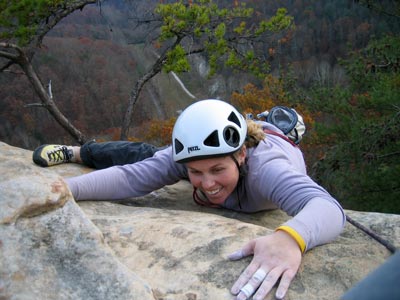 |
|---|
Mantel A way of getting onto a ledge that involves getting a foot up and then putting the weight onto that foot, pushing down with your hands, and standing up - imagine climbing onto a fireplace mantel ledge. Often this is without any good holds above the ledge so involves a fair bit of flexibility, strength, and balance.
Bouldering Climbing without a rope, but low enough that falling is probably ok - often made better with spotters and crash pads.
Highball A bouldering problem that is high enough that you really don't want to fall. This blurs into free soloing. You probably will survive a highball fall but probably wouldn't survive a free solo fall.
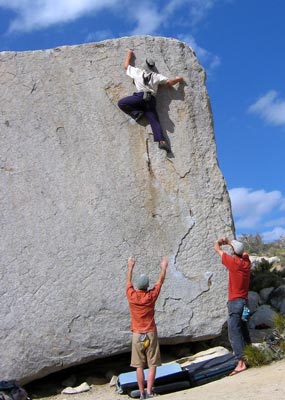 |
|---|
Free solo Climbing without a rope - generally it is a very bad idea to fall while free soloing
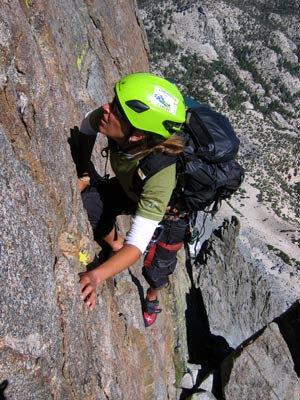 |
|---|
Deep Water Solo Climbing without a rope above deep water so that hopefully if you fall it will be safely into deep water.
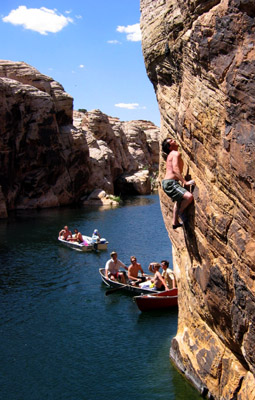 |
|---|
Grade Climbing grade refers to the length of time required for a climb- for example a grade 3 (III) climb would take half a day and a grade 7 (VII) would take over a week - remote alpine expeditions - often with bad weather. With the speeds some climbs are done this can get blurred a lot and of course some climbers are faster or slower than others.
Grade I - one to 2 hours
Grade II - less than half a day
Grade III - half day
Grade IV - full day
Grade V - includes a night on the climb
Grade VI - multi-day/night
Grade VII - a week or longer
Ratings Climbing ratings are a mish mash but generally the higher the number or letter the harder the climb. There are many different scales from different people, places, and countries. An example is the bouldering V scale which goes from V0 up to V16 or so. Every few years someone claims another higher number. The YDS or Yosemite Decimal System goes from 5.1 to 5.15b or so these days. (it originally went up to 5.9 but people kept climbing harder things so they went with 5.10 and then 5.11 and so on). They also use either + or - or letters a through d to make more divisions. (the a through d are only applied for 5.10 and up).
Some rating systems take into account the quality of the protection or the severity of a potential fall.
Someday I'll get a decent chart of grade comparisons up here but meanwhile you can go to wikipedia for probably more than you want...
link to wikipedia climbing grades and rating page
PG Similar to movie ratings - a climb with a PG rating isn't necessarily dangerous, but it isn't totally safe - it requires some attention to safety. There is certainly some potential for a long fall.
R An R rated climb is starting to get a bit risky at parts - there are places where you probably don't want to fall either because there isn't any gear or the gear is of questionable value. A fall in the wrong place might land you in a hospital. If it is a bolted climb the bolts are probably far apart.
X An X rated climb has some real danger potential. A fall in the wrong place might not kill you but will almost certainly cause some damage.
Sandbag to sandbag is to give something a lower grade or rating than it deserves or to lure someone onto something harder than they wanted or expected by telling them it is easier than it really is. 5.9+ can be a notorious sandbag grade because before they started using 5.10 all the hardest climbs were 5.9+ even if they were as hard as what would later become 5.11. There is a long history of sandbagging in climbing.
Whipper, winger, big air, air time A big fall - generally with a rope. How far constitutes a whipper is debatable. I have heard people describing a 2 foot toprope fall as a whipper, but I think it really has to be at least 10 feet or more. Bonus points for ending up close to the ground.
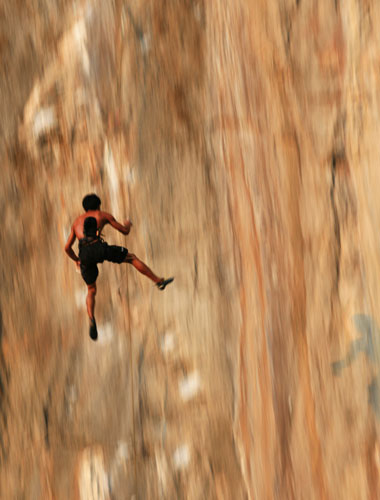 |
|---|
Bat Hang a method of getting a rest by hanging upside down like a bat - usually by wedging your feet or knees in a crack.
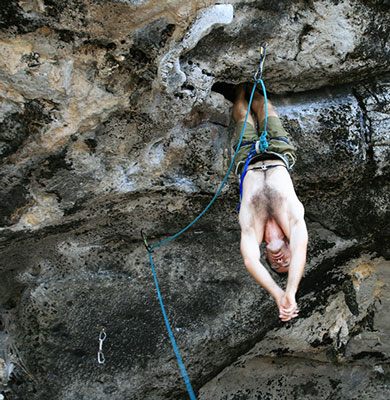 |
|---|
double bowline This knot is used to form a loop in the end of the rope to tie into your harness. The advantage of this knot is that it is relatively easy to untie even after a heavy load. The disadvantage is that if it doesn't have a safety knot on the tail it can work itself loose and it can invert if the loop itself is stressed. Note that the knot in this picture doesn't have a long enough tail or a safety knot.
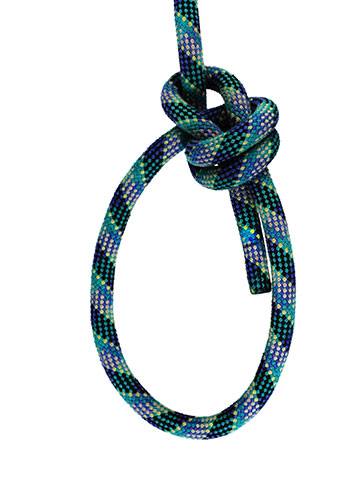 |
|---|
figure eight follow through, 8, figure 8 This knot is used to form a loop in the end of the rope. Most often this is used to tie into your harness by first tieing a figure eight, then passing the end through the harness and then following the rope back through the knot. Note that the knot in this picture doesn't have as long of a tail as you would want for a tie-in knot.
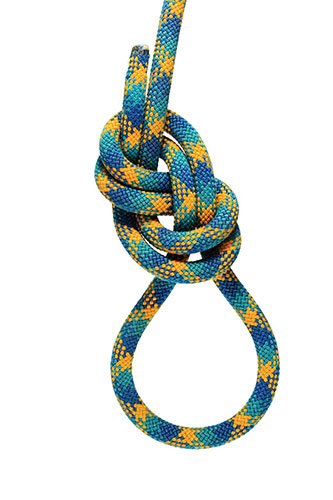 |
|---|
EDK, Euro Death Knot, overhand knot This knot is used to tie 2 ropes together for a double rope rappel. It sounds scary but is secure if it is pulled tight. It has the advantage of being able to rotate to pass edges that might catch another knot when you are pulling the ropes down. A second overhand knot can make it more secure.
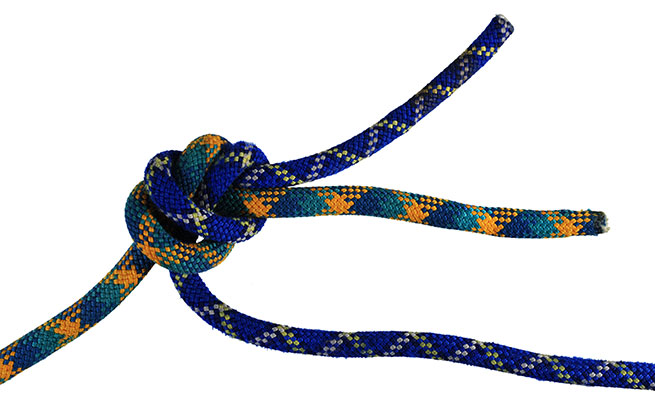 |
|---|
Munter Hitch a knot you can tie on a Carabiner that passes the rope around itself so that it provides friction. It can be used to belay or rappel, but has the disadvantage of increased rope wear and twisting the rope up.
Thrutch Poor form, perhaps a combination of throw and clutch. A person who is thrutching is having trouble. Usually it implies a lot of effort without much success. "I was really thrutching up there and I'm amazed I didn't fall".
Crimp, Crimper Either a small edged hold or the act of grabbing it with a crimp grip. The fingertips are on the hold and the distal joint is bent backwards. This can be very strong but also puts a lot of stress on the fingers. You can also get your thumb in on the action.
 |
|---|
Pocket, Hueco A hole in the rock you use as a hold. Can be tiny or large, sloped or incut.
Mono From the French Mono-doigt A pocket that only fits one finger. It puts a lot of stress on that one finger, but all the others are resting.
Jug, Bucket A big hold - like a jug handle. "I was really worried about the steep part of the climb but it turned out to be a jug haul"
Sloper A hold that slopes or grabbing such a hold. Imagine half a melon on the wall - that would be a sloper.
Sucker Hold A hold that appears to be good but then isn't or else a good hold that leads you off the wrong way or out of sequence.
Knee Bar wedging your knee against something with your foot on the opposite side. It can be very secure and allow no hands resting. Or it can be pretty tenuous - like a knee scum. Using a knee pad can make it more comfortable and more secure, especially if the knee pad has sticky rubber on it.
Drop Knee A move where the foot is placed on a hold and then the leg is rotated inwards until the knee is pointing down. This looks amazingly awkward but can work remarkably well in some situations. It can also put a lot of stress on the knee.
Gaston a hold where you grab a vertical edge with the pinky up and push or pull sideways - trying to pry open an elevator door would be a double gaston - named after the French climber Gaston Rebuffat.
Dyno or Dynamic A dyno is a move where you jump or otherwise make a dynamic move. This can be as severe as an "all points dyno" where none of you is touching the rock for a bit or just a deadpoint where you move up with momentum and grab the hold at the "deadpoint" between moving up and falling back down.
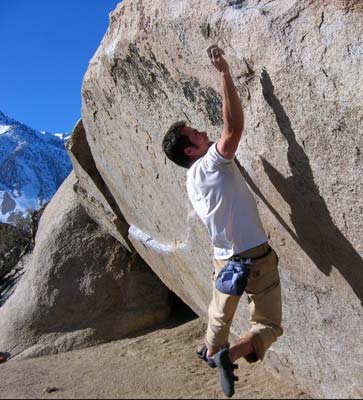 |
|---|
Stem, Stemming Spanning the distance across a gap, generally with your feet. Often used in a chimney or dihedral. This can require some flexibility.
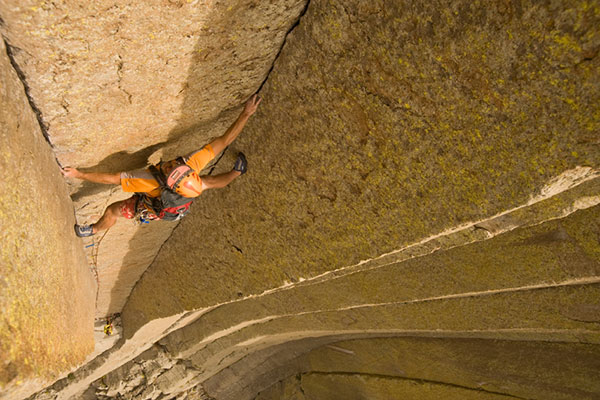 |
|---|
Stick clip, cheater stick A stick that you can fasten a carabiner on the end of to clip to a bolt or piece of gear out of reach above. Often used to clip a rope up to the first or second bolt on a sport climb with a hard or dangerous start. The top of a stick clip can have a clamp or other gizmo to hold a carabiner or rope to make it easier to clip it in. Some even allow the removal of a carabiner or draw that is already up.
Boink, Boinking If a climber falls on a steep climb and is just hanging in space they can boink back up to the climb. This involves them pulling themselves up so there is a slack loop of rope and then letting go. At the same time the belayer pulls up or hangs to take in some of this slack. It can be a rather tedious way to go a short distance, especially if the climber weighs more than the belayer. Sometimes the only alternative is to lower down to the ground or use mechanical means to ascend the rope.
FKT Fastest Known Time - a speed record for something - usually to the top of a peak via a specific route or roundtrip from the trailhead or for a specific trail. Some are very specific and obscure, others are pretty obvious and highly competitive. For example the FKT for the John Muir Trail or Mount Whitney. You can see a lot of them on the FKT site.
Peakbagging a somewhat derogative but not always term for someone who is primarily interested in getting to the top of various peaks - often ones that have little easthetic or other qualities other than being the highest location in an area or a location that is on a list.
Prominence a term referring to how much a peak rises above the highest saddle or col that can be used to get to a higher peak. Sometimes listed as p1k or p1000 for a peak with at least 1000 feet (or meters for those so inclined) of prominence. For a peak that is the high point of an island in the ocean, this is the same as its elevation. For a lower peak, if you raised sea level to the point that it became the highest point of its own island, prominence would be its elevation at that time. Another way to look at it is the minimum amount you would have to descend to go up a higher peak or if you had a 3d topo map and you flipped it over and started pouring water into it at the location of a peak - the depth where the water started spilling over into a deeper section (a higher peak flipped over). This number is further complicated because often the exact elevation of both the summit and more likely the saddle is unknown, so you can use the higher or lower contour lines or average them. Depending on which measure you use peaks might or might not qualify for various prominence cutoffs. With the advent of lidar databases more accurate numbers are available. If it is measured based on topo lines you can report it as the highest it could possibly be (the safest if you want to make sure you don't want to miss any prominent peaks) - what it would be if the elevation was the average or some sort of weighted measure between the contours or the lowest it could be (the safest if you don't want to over represent).
Isolation This is the distance from a given peak to the nearest higher point of land. So the distance from the peak at the moment it is submerged by rising sea levels to the nearest point of remaining land.
Elevation This seems like a very simple number - the height of a point above sea level - or more accurately mean sea level. It is made more complicated by the fact that the surface of the earth is not completely static with various regions rising and falling both slowly and abruptly with earthquakes or other geological processes plus the fact that erosion can lower points and volcanic eruptions or animals (most likely people) piling up material can raise elevations. We have mostly solved the accuracy of surveying with GPS plus satellite and aerial techniques but the actual surface of sea level is also not a sphere and while you can measure it along the coast where you decide it should be inland is a matter of a bit of debate. Thus the elevation of various peaks can change for various reasons including the fact that the elevation actually changes or that they have been measured more accurately or that the location of sea level has changed or been re-interpreted.
X Index This is a way of looking at value X where the index is the total of X where the value of X is greater than the number of instances above that value. Say for X you have values of 5, 4, 3, 2, 1 then the index would be 2 (5 and 4 are greater than 2, 3 is not greater than 3. If you add another 4 - 5, 4, 4, 3, 2, 1 then the index would be 3 (5, 4, 4, and 3<4) adding more values of 4 would not increase the index since 4 is not greater than 4. This way of looking at values is used for Prominence, Isolation, and Elevation among others and is a way of looking at how prolific you are at getting peaks with higher values for these measures. It tends to rise rapidly at first, but then slow down as it becomes increasingly difficult to add more instances with values greater than the index number. For the isolation index (I index) the maximum value is about 360 (in kilometers) since there are about 360 peaks with over 360 kilometers of isolation.
Summit Cookie a cookie eaten on the summit of a peak in celebration or just as an excuse to eat a cookie. You can also have summit sardines, summit snacks, summit sandwiches etc.
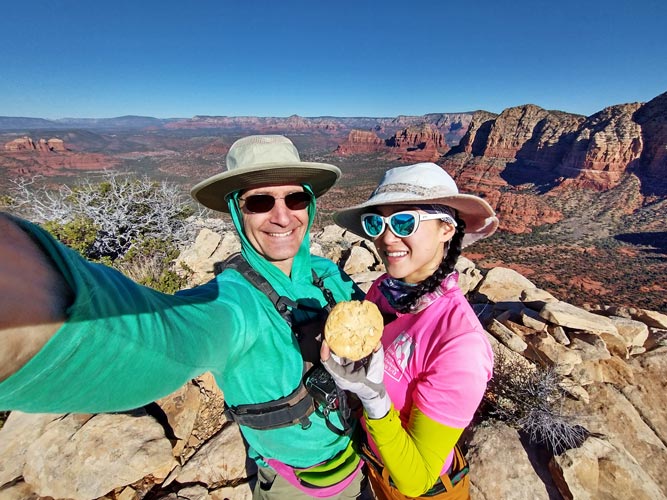 |
|---|
LOJ or List Of John John came up with a computer generated list of peaks based on altitude data - and now LIDAR data. Many of the peaks don't have names - just referred to by their elevation. This is a more comprehensive database and also has less completely made up "peaks". It also includes the high points of various geographic areas - states, parks, wilderness areas, etc. and possibly peaks that are in guidebooks or listed on topo maps.
lots of the most common lists can be found on peakbagger.com list of lists
SPS list The list of 247 peaks (at the time I wrote this) by the Sierra Club Sierra Peaks Section (see link for link to list) or at Peakbagger.com.
DPS list The list of 95 peaks (at the time I wrote this) by the Sierra Club Desert Peaks Section (see link for link to list) or at Peakbagger.com.
HPS list The poorly named list of ~280 or maybe it is 274 peaks by the Sierra Club Hundred Peaks Section or at Peakbagger.com.
14ers List of peaks over 14,000 feet of elevation. I have actually completed most if not all California 14ers lists (it can be a bit arbitrary what peaks are included, and most of the Colorado 14ers - although not Culebra and possibly some other points on the sides of larger peaks).